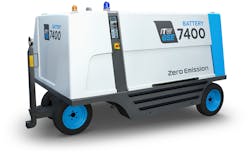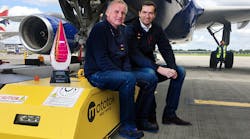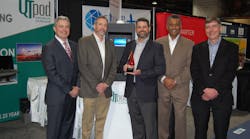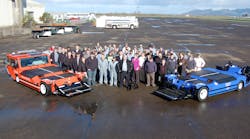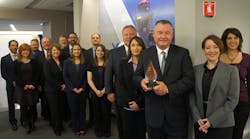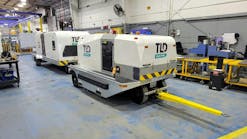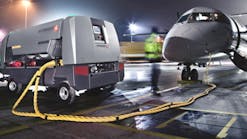ITW GSE: 2020 Product Leader of the Year
With a goal of providing green energy technologies to the ground support industry, ITW GSE sought to create a battery-powered ground power unit (GPU).
But rather than starting from scratch, engineers found a power source and applied it to proprietary equipment already in the field. With Nissan Leaf battery packs onboard, and the company’s 2400 solid-state converter providing output, the 7400 eGPU was born.
The first eGPUs were introduced in Europe in 2018 and debuted in the United States in 2019.
In addition to significantly decreased noise and minimal maintenance, the eGPU reduces carbon dioxide (CO2) emissions by 90 percent and nitrous oxide (NOx) by 95 percent compared with traditional diesel ground power.
For these reasons and others, ITW GSE has been named the Ground Support Worldwide 2020 Product Leader of the Year.
The eGPU’s Introduction to the Market
ITW GSE sought a greener GPU alternative to avoid the amount of emissions coming from diesel-driven GPUs during aircraft turnarounds.
Poul Elvstroem, vice president of sales and marketing at ITW GSE, points out that many pieces of ground support equipment (GSE) used during the turnaround utilize smaller engines, for example, belt-loaders or passenger stairs. Other equipment may have larger engines but are in operation for a short period of time.
Engine driven GPUs, by contrast, have large engines and are in use throughout the turnaround, which requires a substantial amount of diesel fuel.
“When you look at the biggest power consumer when you have an aircraft going through a turnaround, it’s by all means the GPU. It’s the first thing you connect on arrival and it’s the last thing that you disconnect,” Elvstroem says. “So here, you need a lot more battery capacity than you do with any of the other electrical ground support equipment pieces that are parked around the aircraft.”
ITW GSE combined two well-known technologies to create the 7400 eGPU, which can be used anywhere that a 400 Hz supply is needed, including gates, remote parking areas and hangars.
The eGPU is being used throughout the world, with the first unit being put into service in 2018 at Amsterdam Airport Schiphol, Netherlands.
Elvstroem notes previous attempts had been made by companies in the industry to design an eGPU, but ITW GSE’s 7400 is first to launch, go through the proper market testing and receive required certifications.
“We are definitely the first to introduce the eGPU,” he says.
Since the first 7400 was put into service in the fall of 2018, units have been deployed across Europe, the Middle East, Asia, Australia and North America.
In January 2019, the 7400 eGPU was commissioned by United Airlines at Los Angeles International Airport (LAX).
“The challenges are the same, almost throughout the world,” Elvstroem says. “We anticipated that Europe would probably be the most attractive market in the beginning.
“But our learnings have been that we have not been able to predict this,” he adds, pointing to the product’s adoption in the Middle East, Asia and the U.S.
Green Features
Customers that utilize an eGPU can benefit from low emissions, reduced noise and limited maintenance, Elvstroem explains.
“It is running the most and it is also running with a lot of energy – a lot of power, because it is, of course, servicing everything that you switch on onboard the aircraft, during a turnaround,” he says of GPUs.
According to ITW GSE, replacing one diesel-powered GPU with the 7400 eGPU can bring down CO2 emissions by 90 percent, equal to 190,000 pounds, and the NOx by 95 percent.
“But many airports have hundreds of units and that is when it really starts to make a significant impact on things,” Elvstroem says, emphasizing that customers who evaluate their operational needs stand to better reduce emissions and realize more savings.
In contrast to a traditional engine running at speeds of 2,000 rpm or higher, the electric 7400 emits almost zero noise. The reduced noise provides added safety in addition to comfort in the work environment.
“The engine drive GPU has a genset consistent of an engine and generator – a lot of moving and noisy parts. With the eGPU, there are no moving parts inside,” Elvstroem says. “It’s what we call a solid-state technology. It’s quiet. It’s only giving a little bit of a humming sound. But nothing compared to an engine drive.”
Elvstroem says the unit is so quiet, a customer in Holland feared a new unit was not working. The station manager had to explain that it was working, although the ground handler was not used to being able to communicate near the previous GPUs.
“It’s really a significant difference. It’s like from really, really high levels to nothing that you hear out the ramp in an airport, where you basically have noise from all angles anyhow, with pushbacks and aircraft taking off and landing,” Elvstroem says. “In that environment, consider it no noise.”
With no moving parts within the 7400 eGPU, maintenance costs are also reduced significantly. The only parts that need to be maintained are components like the tow-bar, the cable and connector and a few other consumables.
“It’s designed in a way that you never need to access inside the battery packs themselves,” Elvstroem says, adding Nissan provides a five-year standard warranty on its battery packs. “Therefore, there is very little maintenance.”
What’s more, with limited maintenance, fleet capacity can be reduced because each unit’s in-service time increases.
“Apart from you saving heavily on fuel, on top of that you don’t need the same number of units to accommodate the same work,” Elvstroem says, noting the market traditionally has a spare capacity of 20-30 percent diesel GPUs to sustain operations.
The Right Combination of Components
While just one battery pack is needed to power a Nissan Leaf automobile, the ITW GSE 7400 eGPU uses four packs in its standard 90 kVA unit.
“We need more power than what is in one Nissan Leaf car to power maybe 10 or 15 aircraft turnarounds between charging,” Elvstroem explains, noting the 7400 eGPU is designed to operate for a full day and can charge during an airport’s lowest operational periods.
“It’s key not to charge during peak hours,” he continues. “During peak hours, the entire infrastructure at the airport is stressed with all these other charging systems, anyhow. So with this, when you have a low peak, then you charge.”
When recharging is required, the 7400’s onboard charger allows recharging from any three-phase 50 or 60 Hz outlet. This eliminates the need for a charging station or frees up capacity at a charging station for other pieces of GSE. It takes 2-3 hours to recharge from nearly zero to full capacity.
“It has a financial cost to add these chargers and build them into the product, instead of having them externally. But the benefit is just as easily compensated because now you don’t need to go out and invest in kinds of other charging systems before you start an operation,” Elvstroem says, noting nearly 20 demos are taking place at airports currently, due in large part to the onboard charging system being available.
The Lithium-ion battery packs can handle 10-15 turnarounds, subject to the aircraft’s size and configuration. ITW GSE is building communication software into the 7400 to monitor usage in the field and better understand power requirements.
With the power input generated with Nissan’s battery packs, the output is controlled by ITW GSE’s 2400 solid-state converter.
“That is a converter that we have produced for many years. We have thousands and thousands of this product out in the field. That is the unit that are mounted under the passenger boarding bridges in many airports or used as fixed on remote parking, fixed inside hangars, what have you,” Elvstroem says.
“We have taken our core product and combined it with a well-proven battery,” he adds. “This way, we are limiting the technological risk of trying out something that has not been proven or tested.”
It shares common parts with ITW’s other ground support pieces and the user interface of the 7400 is identical to other products, including diesel GPUs, pre-conditioned air (PCA) units and solid-state GPUs.
“It’s very easy for the operators to recognize and find out how to operate this equipment,” Elvstroem says.
An Expanded Product Line
ITW GSE has expanded on its standard eGPU 90 kVA unit. The company has added the ITW GSE 7400 JetEx a 28 VDC battery-driven eGPU, which requires just one battery pack. Later in 2020, the company is launching a 180 kVA 400 Hz AC eGPU for the largest aircraft.
“By end of Q3 this year, we’ll have a complete range of battery-driven ground power units that can replace all the different engine-driven ground powers being used in the field today,” Elvstroem says.
Elvstroem acknowledges that the initial investment in new technology can be significant.
“The first thing people say is, ‘It’s too costly. It’s too expensive.’ But they are basing it purely on capital investment comparison with the cost of a diesel-driven GPU,” Elvstroem says.
However, ITW GSE offers a calculating tool to customers to better understand a unit’s total cost of ownership.
“I think we are the proudest of making a product that is both so much greener and at the same time so much cheaper to operate,” Elvstroem says. “Technology put together in the right way, really makes a difference.”
